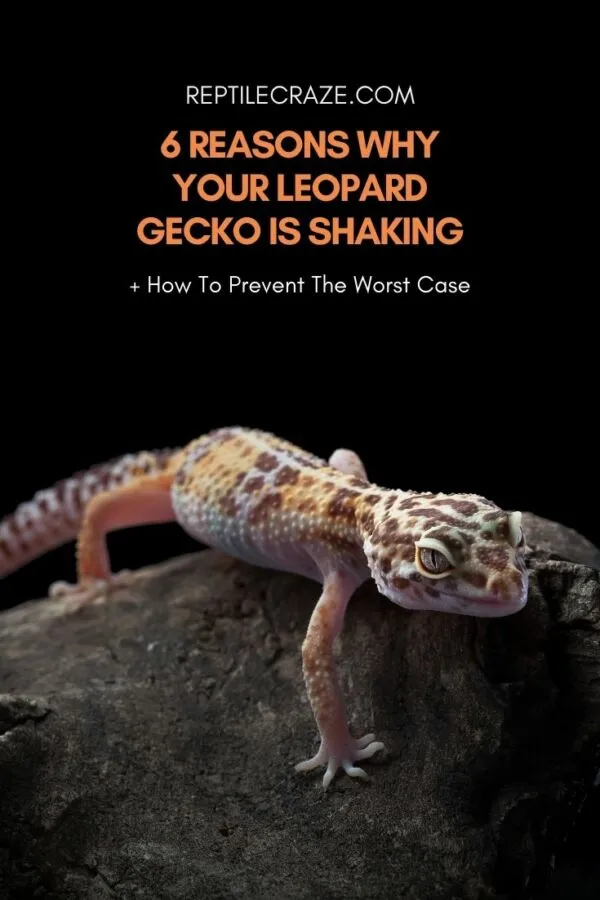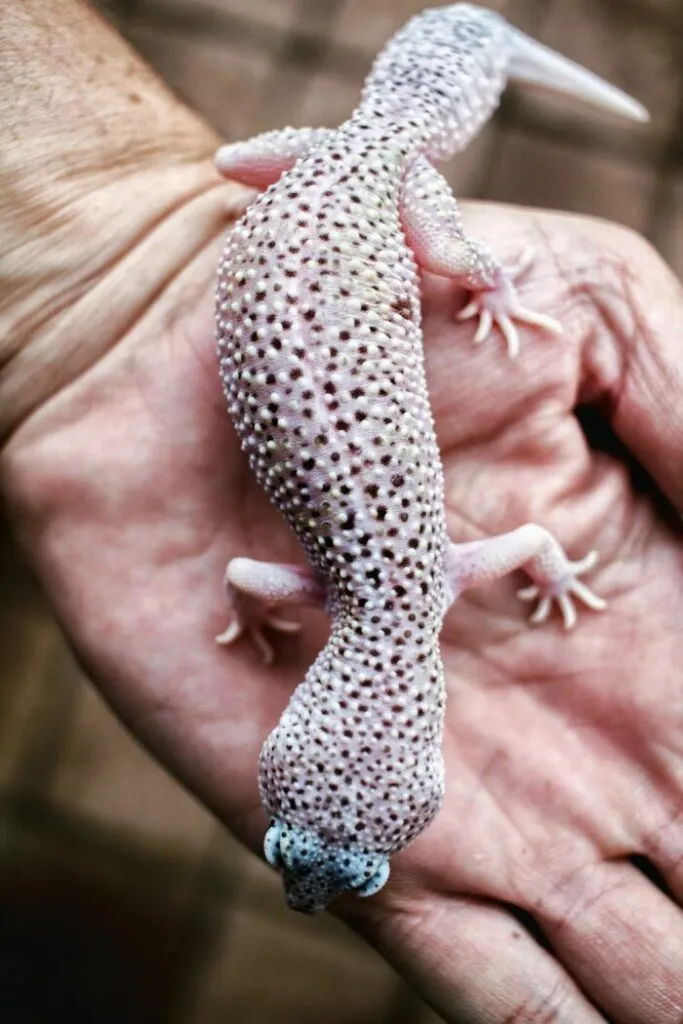
It can really be unnerving when you suddenly see your once calm leopard gecko, suddenly shaking. Does it have a serious illness? Is it just due to stress? And most importantly, is there something that you can do to stop it from shaking?
Shaking in leopard geckos can be caused by stress, behavior associated with eating, socialization, and shedding. A leopard gecko also may be shaking if it suffers from Metabolic Bone Disease, a disease that causes bones to be rubbery and soft. The root cause for this is often calcium deficiency.
In this article, we are going to talk about the possible causes of shaking in your leopard gecko. Do not panic just yet, as more often than not, this behavior does not equate to your leo having a disease. At the same time, we are going to discuss the things you can do to prevent this from happening.
Table of Contents
Causes Of Shaking In Leopard Geckos
As we have mentioned earlier, there can be a lot of reasons behind the sudden shaking of your leo. We can categorize the causes into two, which are abnormal and normal causes. Let us take a look at both of them.
Normal Causes
It does not necessarily mean that your leopard gecko is sick when it is shaking. In fact, subtle and even immense shaking may just be the nature of your leo. Let us now take a look at some of the normal causes of shaking in leopard geckos.
Keep in mind that even though they are normal causes, you still need to regulate the behavior so that the cause will not get aggravated.
Some Leopard Geckos Shake To Communicate
A leopard gecko will sometimes shake its body as a way of saying, “Hey, I’m here!” For some first-time owners, they might think that their leo is shaking its entire body, but the truth is it is only shaking its tail.
Male leopard geckos will usually do this when there are female leopard geckos as a way of introducing themselves. Cute, right? This wiggling or shaking behavior can range from slow to immense shaking that may or may not be associated with mating behavior.
Further, leopard geckos can do this shaking behavior in anticipation of certain things in their environment. If they are already used to a feeding schedule, sometimes they are seen subtly shaking inside their hides come feeding time.
Shaking Can Be A Defensive Strategy
When you see that your leopard gecko is shaking vigorously at another leopard gecko, then it is simply showing a defensive strategy. Leos sometimes shake when they feel that they are under attack, irritated, or threatened.
They can also do these energetic shakes during offensive situations such as when it is attacking another leopard gecko or hunting for
Interesting fact: Leopard geckos use their tail as a distraction. In some cases, they would rather lose their tails than their lives.
Another owner shared that his leopard gecko tends to shake when he moves around things inside the enclosure. His leo was already used to him and was used to handling, yet it displayed this defensive shaking when there is a change in its environment.
Leopard Geckos Sometimes Shake When They Eat
Another behavior that is mistaken as full body shaking is when your leopard gecko shakes its head aggressively. A lot of times as the head shaking is so aggressive, it looks like the whole body of your leo is also shaking.
What is actually happening is that your leopard gecko is trying to swallow a larger feeder than it is used to. Another possibility is that the way that the feeder was ingested was irregular, so it has a bit of difficulty swallowing.
A lot of times, this is not a cause for worry because it is natural for lizards to do certain aggressive movements to pass their
On the other hand, just make sure that your leo is not choking. Usually, when this is the case, shaking is paired with vocalization. So it is best to monitor your leo if it starts to shake rapidly immediately after eating. To be safe, make sure that their feeders are not too large for them to handle.
Stress Can Cause Shaking In Leopard Geckos
Leopard geckos also shake when there is something that causes them stress in their environment. It can be another leopard gecko, things around the enclosure, and it can even be because of you!
A lot of leo owners have been wondering about the sudden shaking of their leos when there are clearly no problems present internally and externally. A lot of them theorize that it can also be due to the owners themselves. The main culprit? Constant handling.
Your leo might be shaking when you get close to its enclosure in anticipation of “handling time.” As much as we love to hold our leos, keep in mind that even though they tolerate it, it is still not a natural act for them.
Leopard Geckos Often Shake When They Shed
When it is nearing their time to shed, the skin on their body will feel tight. Just like humans, if we feel something is tight, we squirm around trying to find a comfortable position. The same goes for your leo!
If it is still too early to shed, they may move uncomfortably and shake a bit while they are walking in order to move properly. The biggest clue if this is the reason for shaking is when this behavior is displayed while the color of the skin of your leo is already dull.

Abnormal Causes
No matter how much we like to start off this article in a good note, we also want to express the sense of urgency that is needed when you see your leopard gecko shaking. In a lot of cases, this behavior is closely associated with a disease.
Metabolic Bone Disease (MBD)
This disease is brought about by calcium deficiency. What happens is that the bones of your leo will turn soft and rubbery that they will have difficulty moving and performing normal activities.
Another thing to note is that if you suspect that your leo is suffering from this disease, it is crucial to rush it to the vet as immediate treatment is essential to the survival of your leo. At its early stages, it can still be completely treated, but the recovery process is slow.
Important note: Calcium is extremely important to leopard geckos as it helps in metabolic processes and having proper bone density. If there is too much or too little consumption of calcium, your leopard gecko will develop health problems. Balance is the key!
Here are the symptoms of Metabolic Bone Disease:
- Shaking (can just be the legs or the whole body)
- Deformed Jaw
- Lethargy
- Back is twisted or crooked
- Spasms
- Anorexia
- Constipation
- Gut rot
Treatment Of Metabolic Bone Disease
If you caught a probable symptom of Metabolic Bone Disease at its early stages, you can easily remedy it at home. You can simply dust your feeders with calcium powder that also has Vitamin D3. Further, you can put a container that contains these supplements inside the enclosure so your leo can lick it whenever it needs to.
On the other hand, if you caught it too late and two or more of the symptoms that we discussed are already present, you need to rush to the vet as this disease can be life-threatening. For some owners, they just keep up the calcium regimen for a month and they wait for a month with no development before consulting a vet.
This can be done, especially if you are a long-time owner of a leo and you have dealt with this issue before. Also, more often than not, when it is still in the early stages, your leo can still bounce back when it gets its proper fill of calcium.
However, if you are not so sure as to what is happening to your leo, we highly encourage you to consult your vet. There is nothing wrong with a quick check-up to ensure that the treatment that you are doing is truly helping your leo.
How To Prevent Calcium Deficiency
In our earlier discussion about the abnormal cause of shaking in leopard geckos, we mentioned that it can be caused by Metabolic Bone Disease. As this is due to calcium deficiency, let us now talk about the things that you can do for this not to happen.
Importance of Calcium and Vitamin D3
We cannot stress enough the importance of calcium to your leopard geckos. Basically, calcium is the driving force for any type of movement of your leo.
Without calcium, their bones will turn into jelly and they simply cannot move nor eat. When leos are in the wild, they get calcium and Vitamin D3 from the UVB rays of the sun and consuming insects that are rich in calcium.
In a controlled environment, they should get their proper fix of calcium and Vitamin D3 with supplements that are mixed with their feeders.
Feeding Amount (Calcium+Vitamin D3)
We really cannot say the exact amount of calcium and Vitamin D3 that you should give to your leopard geckos. It has a lot to do with observance and trial and error. Therefore, you can use the guide below and adjust accordingly on how well your leo responds.
| Age | Frequency |
| 0-6 months | Everyday |
| 6-12 months | Every other day |
| 12+ months | Every three to four days |
In order to make sure that you are dusting your feeders properly, you can put the supplement in a ziplock bag and add the feeders there. In this case, the feeders will be completely covered with the supplement. No wastage of supplement here!
Final Thoughts
Shaking behavior in leopard geckos can really be alarming especially if you do not have any idea as to what may be causing it. Now, you do not have anything to worry about as we have covered all the possible causes.
Even if the cause falls under the normal or abnormal causes, you now know that you can easily find a solution. So just observe your leopard gecko intently, so you can respond to its needs appropriately.
- Enchi Ball Python: A Unique and Stunning Morph of Python regius - March 27, 2025
- Emerald Tree Monitor: The Enigmatic Green Guardian of the Rainforest - March 26, 2025
- The Egyptian Cobra (Naja haje): A Fascinating Serpent - March 25, 2025
